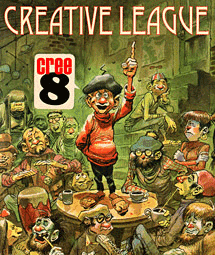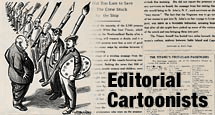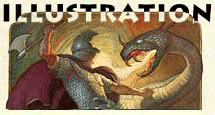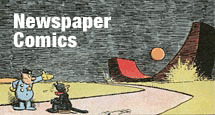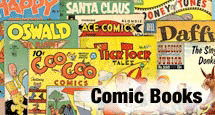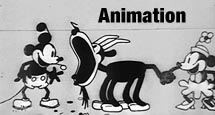This posting is a stub. You can contribute to this entry by providing information through the comments link at the bottom of this post. Please organize your information following the main category headers below….
Birth/Death
Birth: 24 March, 1901, Kansas City, Missouri
Death: 7 July, 1971 Burbank, CA
Occupation/Title
Animator/Director/Producer
Bio Summary
Iwerks was working as an artist at the Pesman-Rubin Commercial Art Studio in Kansas City when he met Walt Disney. They became good friends and colleagues. They made notable attempts at starting their own business together in Kansas City including Laugh-O-Gram films, but all failed. Finally Disney went to Hollywood, broke and unemployed. There he started an animation company. Lacking talent, he called his old friend Iwerks, who immediately packed up and headed for California. Notable productions from this time include the Alice series and Oswald the Rabbit.
When Charles Mintz took the Oswald character and Walt’s employees from him in 1928, Iwerks remained loyal and stayed with Disney’s studio. It was from this set-back that Iwerks first animated Mickey Mouse. Iwerks was the lead animator on the Mickey Mouse shorts and soon Steamboat Willie made history by adding sound to the then silent films. It wasn’t easy working for Disney in those days and Iwerks took the brunt of Disney’s rage.
It was in 1930 that Pat Powers offered Iwerks the chance to run his own studio. He jumped at the offer. He created the characters Flip the Frog, Willie Whopper, but they never gained great public support. By 1936 the studio lost its financial backers and went under.
After that Iwerks went to work, primarily, as a visual effects director and in 1940 returned to work for Disney.
Early Life/Family
Born an only child of Dutch and German descent, Iwerks grew up in a poor household in Missouri. His father left the family when Iwerks was young.
Education/Training
When his father left the family Iwerks was forced to quit school and work to support his mother. At age 18 he attended the Art Institute of Kansas City.
Career Outline
Artist, Pesmin-Rubin Commercial Art Studios
Artist, Iwerks-Disney
Artist, Kansas City Slide Company
Animator, Laugh-O-Grams, Inc.
Artist, The Kansas City Film Ad
Animator/Director, The Disney Brothers Studio/Walt Disney Studios
Producer, Ub Iwerks Studios
Visual Effects Director, Columbia
Visual Effects Director, Walt Disney Studios
Influences
Personality
Iwerks was considered a quiet and reserved man with a quirky sense of humor.
Anecdotes
He had a free and flowing style, arguably the finest animator of his time. Iwerks was considered to be the greatest contributor to the success of Walt Disney. Iwerks out produced other animators 2 to 1 drawing 700 frames a day on Plane Crazy.
Miscellaneous
Ub Iwerks widow, Mildred, died in 1992.
Filmography
Director – filmography
Little Orphan Willie (1930)
A Busy Day (1940)
Beauty Shoppe (1940)
Baby Checkers (1940)
Blackboard Revue (1940)
The Egg Hunt (1940)
Ye Olde Swap Shoppe (1940)
Wise Owl (1940)
Willoughby’s Magic Hat (1943)
Magic Strength (1944)
Carnival Courage (1945)
Plane Crazy (1928)
Steamboat Willie (1928)
The Gallopin’ Gaucho (1928)
The Barnyard Battle (1929)
The Plowboy (1929)
Mickey’s Choo-Choo (1929)
Springtime (1929)
Hell’s Bells (1929)
Puddle Pranks (1930)
Summer (1930)
Autumn (1930)
Arctic Antics (1930)
Fiddlesticks (1930)
Flying Fists (1930)
The Village Barber (1930)
Cuckoo Murder Case (1930)
The Village Smithie (1931)
The Soup Song (1931)
Laughing Gas (1931)
Ragtime Romeo (1931)
The New Car (1931)
Movie Mad (1931)
The Village Specialist (1931)
Jail Bird (1931)
Africa Squeaks (1931)
Spooks (1931)
The Milkman (1932)
Fire! Fire! (1932)
What a Life (1932)
Puppy Love (1932)
School Days (1932/I)
Bully (1932)
The Office Boy (1932)
Room Runners (1932)
Stormy Seas (1932)
Circus (1932)
The Goal Rush (1932)
Phoney Express (1932)
The Music Lesson (1932)
Nurse Maid (1932)
Funny Face (1932)
The Air Race (1933)
Coo Coo the Magician (1933)
Flip’s Lunch Room (1933)
Techno-Cracked (1933)
Bulloney (1933)
Chinaman’s Chance (1933)
Pale-Face (1933)
Play Ball (1933)
Soda Squirt (1933)
Spite Flight (1933)
Stratos-Fear (1933)
Jack and the Beanstalk (1933)
Davy Jones’ Locker (1933)
Hell’s Fire (1934)
… aka Masquerade Holiday (USA: video catalogue title)
Robin Hood, Jr. (1934)
The Brave Tin Soldier (1934)
Insultin’ the Sultan (1934)
Puss in Boots (1934)
Reducing Creme (1934)
Rasslin’ Round (1934)
The Queen of Hearts (1934)
Cave Man (1934)
… aka The Caveman (USA)
Jungle Jitters (1934)
Aladdin and the Wonderful Lamp (1934)
Good Scout (1934)
Viva Willie (1934)
The Headless Horseman (1934)
The Valiant Tailor (1934)
Don Quixote (1934)
Jack Frost (1934) (uncredited)
The Microbe Army (1935)
Little Black Sambo (1935)
The Brementown Musicians (1935)
Old Mother Hubbard (1935)
Mary’s Little Lamb (1935)
Summertime (1935)
… aka In the Good Ol’ Summertime
Sinbad the Sailor (1935) (uncredited)
The Three Bears (1935)
Balloon Land (1935)
… aka The Pincushion Man
Simple Simon (1935)
Humpty Dumpty (1935)
Big Bad Wolfe (1936) (uncredited)
… aka The Big Bad Wolf (USA)
Ali Baba (1936)
Tom Thumb (1936)
Dick Whittington’s Cat (1936)
Little Boy Blue (1936)
Happy Days (1936)
Two Lazy Crows (1936)
Skeleton Frolics (1937)
Scrappy’s Trip to Mars (1937)
Merry Mannequins (1937)
Porky and Gabby (1937)
Foxy Pup (1937)
Porky’s Super Service (1937)
Horses on the Merry-Go-Round (1938)
Showtime (1938)
The Frog Pond (1938)
Midnight Frolics (1938)
The Gorilla Hunt (1939)
Nells Yells (1939)
Producer – filmography
Puddle Pranks (1930) (producer)
Fiddlesticks (1930) (producer)
Flying Fists (1930) (producer)
The Village Barber (1930) (producer)
Cuckoo Murder Case (1930) (producer)
The Village Smithie (1931) (producer)
The Soup Song (1931) (producer)
Laughing Gas (1931) (producer)
Ragtime Romeo (1931) (producer)
The New Car (1931) (producer)
Movie Mad (1931) (producer)
The Village Specialist (1931) (producer)
Jail Bird (1931) (producer)
Africa Squeaks (1931) (producer)
Spooks (1931) (producer)
The Milkman (1932) (producer)
Fire! Fire! (1932) (producer)
What a Life (1932) (producer)
Puppy Love (1932) (producer)
School Days (1932/I) (producer)
Bully (1932) (producer)
The Office Boy (1932) (producer)
Room Runners (1932) (producer)
Stormy Seas (1932) (producer)
Circus (1932) (producer)
The Goal Rush (1932) (producer)
Phoney Express (1932) (producer)
The Music Lesson (1932) (producer)
Nurse Maid (1932) (producer)
Funny Face (1932) (producer)
Willie Whopper (1933) (producer)
Coo Coo the Magician (1933) (producer)
Flip’s Lunch Room (1933) (producer)
Techno-Cracked (1933) (producer)
Bulloney (1933) (producer)
Chinaman’s Chance (1933) (producer)
Pale-Face (1933) (producer)
Play Ball (1933) (producer)
Soda Squirt (1933) (producer)
Spite Flight (1933) (producer)
Stratos-Fear (1933) (producer)
Jack and the Beanstalk (1933) (producer)
Davy Jones’ Locker (1933) (producer)
Hell’s Fire (1934) (producer)
… aka Masquerade Holiday (USA: video catalogue title)
Robin Hood, Jr. (1934) (producer)
The Little Red Hen (1934) (producer)
The Brave Tin Soldier (1934) (producer)
Insultin’ the Sultan (1934) (producer)
Puss in Boots (1934) (producer)
Reducing Creme (1934) (producer)
Rasslin’ Round (1934) (producer)
The Queen of Hearts (1934) (producer)
Cave Man (1934) (producer)
… aka The Caveman (USA)
Jungle Jitters (1934) (producer)
Aladdin and the Wonderful Lamp (1934) (producer)
Good Scout (1934) (producer)
Viva Willie (1934) (producer)
The Headless Horseman (1934) (producer)
The Valiant Tailor (1934) (producer)
Don Quixote (1934) (producer)
Jack Frost (1934) (producer)
The Microbe Army (1935) (executive producer)
The Brementown Musicians (1935) (producer)
Old Mother Hubbard (1935) (producer)
Mary’s Little Lamb (1935) (producer)
Summertime (1935) (producer)
… aka In the Good Ol’ Summertime
Sinbad the Sailor (1935) (producer)
The Three Bears (1935) (producer)
Balloon Land (1935) (producer)
… aka The Pincushion Man
Simple Simon (1935) (producer)
Humpty Dumpty (1935) (producer)
Ali Baba (1936) (producer)
Tom Thumb (1936) (producer)
Dick Whittington’s Cat (1936) (producer)
Little Boy Blue (1936) (producer)
Happy Days (1936) (producer)
Two Lazy Crows (1936) (producer)
Skeleton Frolics (1937) (producer)
Scrappy’s Trip to Mars (1937) (producer)
Merry Mannequins (1937) (producer)
Foxy Pup (1937) (producer)
Horses on the Merry-Go-Round (1938) (producer)
Showtime (1938) (producer)
The Frog Pond (1938) (producer)
Midnight Frolics (1938) (producer)
The Gorilla Hunt (1939) (producer)
Nells Yells (1939) (producer)
Crop Chasers (1939) (producer)
A Busy Day (1940) (producer)
Beauty Shoppe (1940) (producer)
Baby Checkers (1940) (producer)
Miscellaneous Crew – filmography
Cinderella (1922/I) (animator)
Alice’s Wonderland (1923) (animator)
Alice’s Day at the Sea (1924) (animator)
Alice the Peacemaker (1924) (animator)
Alice Gets in Dutch (1924) (animator)
Alice Hunting in Africa (1924) (animator)
Alice and the Three Bears (1924) (animator)
Alice the Piper (1924) (animator)
Plane Crazy (1928) (animator)
Steamboat Willie (1928) (animator)
The Gallopin’ Gaucho (1928) (animator)
The Barn Dance (1929) (animator)
The Skeleton Dance (1929) (animator)
The Cactus Kid (1930) (animator)
Little Black Sambo (1935) (animator)
Sinbad the Sailor (1935) (animator) (as U.B. Iwerks)
Simple Simon (1935) (animator)
Big Bad Wolfe (1936) (animator) (as U.B. Iwerks)
… aka The Big Bad Wolf (USA)
Make Mine Music (1946) (process effects)
Melody Time (1948) (special processes)
The Adventures of Ichabod and Mr. Toad (1949) (special processes)
… aka Ichabod and Mr. Toad (USA: promotional title)
… aka The Legend of Sleepy Hollow (USA: TV title)
… aka The Madcap Adventures of Mr. Toad
Cinderella (1950) (special processes)
Alice in Wonderland (1951) (special processes)
Peter Pan (1953) (special processes)
Bear Country (1953) (special process)
Davy Crockett, King of the Wild Frontier (1954) (special
processes)
… aka Episode 1: Davy Crockett – Indian Fighter (USA: TV title)
… aka Episode 2: Davy Crockett Goes to Congress (USA: TV title)
… aka Episode 3: Davy Crockett at the Alamo (USA: TV title)
20000 Leagues Under the Sea (1954) (special processes)
… aka Jules Verne’s 20,000 Leagues Under the Sea (USA: reissue
title)
Men Against the Arctic (1955) (special process)
Man in Space (1955) (TV) (special processes)
Lady and the Tramp (1955) (special processes)
The Great Locomotive Chase (1956) (special processes)
… aka Andrews’ Raiders (USA: TV title)
Davy Crockett and the River Pirates (1956) (special processes)
Secrets of Life (1956) (special process)
Westward Ho the Wagons! (1956) (special processes)
… aka Johnny Tremain and the Sons of Liberty
Johnny Tremain (1957) (special processes)
Sleeping Beauty (1959) (special processes)
… aka Walt Disney’s 101 Dalmatians (USA: alternative title)
One Hundred and One Dalmatians (1961) (special processes)
The Birds (1963) (special photographic advisor)
… aka Alfred Hitchcock’s The Birds (UK: complete title)
Special Effects – filmography
The Reluctant Dragon (1941) (special effects)
… aka A Day at Disneys (USA: TV title)
… aka Behind the Scenes at Walt Disney Studio
The Three Caballeros (1944) (process effects)
Song of the South (1946) (special photographic processes)
Fun and Fancy Free (1947) (process effects)
So Dear to My Heart (1948) (special effects)
Beaver Valley (1950) (process photography)
… aka In Beaver Valley
One Hour in Wonderland (1950) (TV) (special processes)
Toby Tyler, or Ten Weeks with a Circus (1960) (special effects)
… aka Toby Tyler
Pollyanna (1960) (special effects)
“Disneyland”
… aka Disney’s Wonderful World (USA: new title)
… aka The Disney Sunday Movie (USA: new title)
… aka The Magical World of Disney (USA: new title)
… aka The Wonderful World of Disney (USA: new title)
… aka Walt Disney (USA: new title)
… aka Walt Disney Presents (USA: new title)
… aka Walt Disney’s Wonderful World of Color (USA: new title)
– The Three Lives of Thomasina: Part 3 (1965) TV Episode
(special effects)
– The Three Lives of Thomasina: Part 2 (1965) TV Episode
(special effects)
– The Three Lives of Thomasina: Part 1 (1965) TV Episode
(special effects)
– Toby Tyler: Part 2 (1964) TV Episode (special effects)
– Toby Tyler: Part 1 (1964) TV Episode (special effects)
(3 more)
The Three Lives of Thomasina (1964) (special effects)
The Parent Trap (1961) (special photographic effects)
Ten Who Dared (1960) (special effects)
Visual Effects – filmography
Man and the Moon (1955) (TV) (visual effects producer)
… aka Tomorrow the Moon (USA: reissue title)
Filmography as: Director, Producer, Miscellaneous Crew, Special
Effects, Visual Effects, Writer, Actor, Cinematographer, Archive
Footage
White Wilderness (1958) (special processes)
… aka Large Animals of the Arctic (cut version)
… aka The Lemmings and Arctic Bird Life (cut version)
Writer – filmography
Steamboat Willie (1928)
The Microbe Army (1935)
Actor – filmography
Alice’s Wonderland (1923)
Cinematographer – filmography
Alice’s Wonderland (1923) (as Ubbe Iwerks)
Archive Footage
Walt: The Man Behind the Myth (2001) (TV) …. Himself (animator)
The Hand Behind the Mouse: The Ub Iwerks Story (1999) …. Himself
Honors
Annie Award: Winsor McCay Award 1978
Oscar – Traveling Matte Method of Animation?Oscar – General contributions to the Industry?Kalmas Gold Medal Award
Related Links
Bibliographic References
Serious Business, Stefan Kanfer
The Hand Behind the Mouse: The Ub Iwerks Story
BIO-AAA-006
Contributors To This Listing
Barry Foust
To make additions or corrections to this listing, please click on COMMENTS below…





